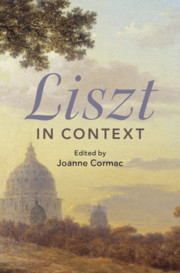Book contents
- Liszt in Context
- Composers in Context
- Liszt in Context
- Copyright page
- Contents
- Illustrations and Tables
- Contributors
- Preface
- Part I People and Places
- Chapter 1 Family Background
- Chapter 2 Liszt’s Teachers
- Chapter 3 Paris
- Chapter 4 Italy
- Chapter 5 Liszt and Wagner
- Chapter 6 The New German School
- Chapter 7 Weimar
- Chapter 8 Liszt and His Contemporaries
- Chapter 9 Liszt in Hungary
- Part II Society, Thought and Culture
- Part III Performance and Composition
- Part IV Reception and Legacy
- Further Reading
- Index
Chapter 4 - Italy
from Part I - People and Places
Published online by Cambridge University Press: 23 September 2021
- Liszt in Context
- Composers in Context
- Liszt in Context
- Copyright page
- Contents
- Illustrations and Tables
- Contributors
- Preface
- Part I People and Places
- Chapter 1 Family Background
- Chapter 2 Liszt’s Teachers
- Chapter 3 Paris
- Chapter 4 Italy
- Chapter 5 Liszt and Wagner
- Chapter 6 The New German School
- Chapter 7 Weimar
- Chapter 8 Liszt and His Contemporaries
- Chapter 9 Liszt in Hungary
- Part II Society, Thought and Culture
- Part III Performance and Composition
- Part IV Reception and Legacy
- Further Reading
- Index
Summary
The ancient Roman figure of Janus, with his two faces – one looking towards the past, the other towards the future – serves as a fitting image for Liszt’s first encounter with Italy in the late 1830s. The region’s breathtaking beauty has been credited with luring him over the Alps. As Chateaubriand once noted: ‘Nothing is comparable to the beauty of the Roman horizon, to the sweet inclination of the plains as they meet the soft and flowing contours of the hills.’1 Such sensual descriptions attracted many visitors to Italy, but there was more to Liszt’s travels than scenic diversion. When he first journeyed south in August 1837, he and his companion, Marie d’Agoult, joined a steady stream of artists, aristocrats, writers and musicians who for centuries had made the long and difficult trip. Like these travellers, Liszt was drawn by Italy’s reputation as the cradle of European culture and by the beauty of its literature and art. Indeed, it was the literature and art of Italy’s past that made the most lasting impression on Liszt’s aesthetic ideas and later efforts as a composer.
- Type
- Chapter
- Information
- Liszt in Context , pp. 29 - 37Publisher: Cambridge University PressPrint publication year: 2021

